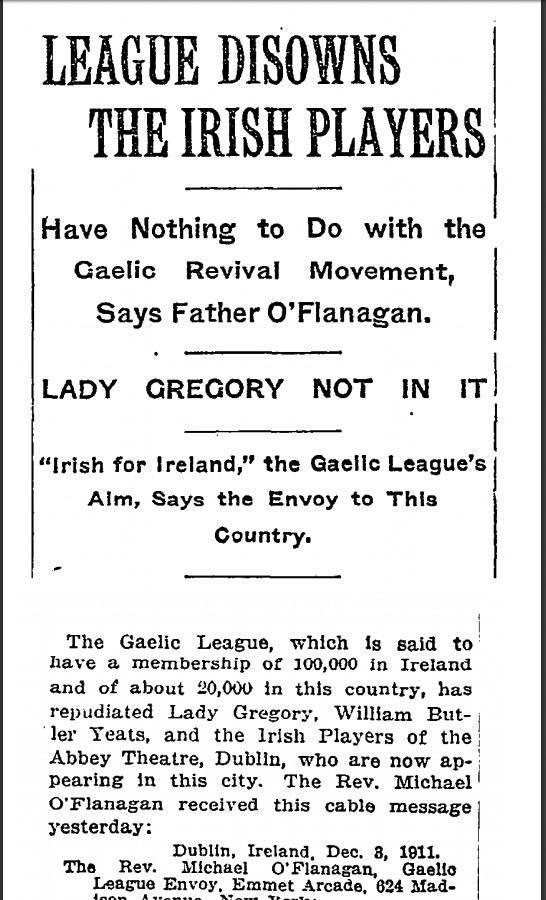Gaelic League 1910—1912
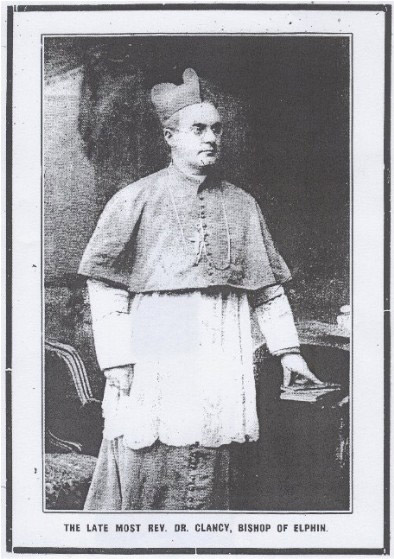
In June of 1910 Fr. O'Flanagan returned to Ireland. In August, after attending a meeting he was elected to the executive of the Gaelic League. He reported 'the existence in every part of the States of an Irish population that is ever anxious to hear of home progress and to meet any representatives of any Irish movement'. Within a few weeks of his appointment to the standing committee the Gaelic League asked him to return to United States on another fundraising mission.
Along with Fionan McColum he traveled back to America to commence another round of fundraising. He went with the blessing of Bishop Clancy, who published a letter congratulating Fr. O'Flanagan on his selection. This mission was 'moderately successful' remitting £3,054 between March 1911 and July 1912. He returned to Ireland where Bishop Clancy appointed him curate in Roscommon in 1912.
The following articles are from newspapers reporting on his trip.
Meeting held to promote the Gaelic language
The attendance at the meeting of the Irish Language society, last night, was disappointingly small, but the enthusiasm of those present was great. The percentage of those who understand Gaelic was large, as was shown by the manner in which the speech of Fionan MacColum, in the Gaelic was received.
The decorations of the theatre were simple but in good taste, being limited to a few Irish and American flags. The principal speaker of the evening, Rev. Michael O'Flanagan, made a splendid address, closing with an eloquent appeal to help the movement along and not allow the Gaelic language, the language of their forefathers, to perish but rather to so encourage the movement that it will eventually roll back the wave Anglicism that has so long cursed Ireland. He spoke entirely in English except his opening sentences which were in Gaelic.
The concert given in connection with the lecture was excellent and was composed entirely of Irish music. Mrs. E. J. O'Neil with her splendid contralto voice was heard to a good advantage in two Irish songs that touched the hearts of her hearers, they being 'Mavourneen Dilish' and 'When Shall the Day Break in Ireland?' Both were well sung and with the proper amount of feeling and expression. Miss Anna Hartigan pleased in her two selections, 'Kilarney,' and 'The Meeting of the Waters.' . John Hughes was good, as he always is, he singing 'Sentenced to Death,' and 'They Have Won Every Nation's Battles But Their Own.' Miss N. O. O'Mahoney of New Haven also sang very sweetly two songs. Greatly to the disappointment of the committee, F. Coffee of New York, who was expected to be present and play the Irish war pipes wearing an old time Irish costume, was unable to be here on account of sickness.
The two envoys arrived on the 5:27 train from Boston, and were met at the station by a majority of the committee and escorted to the Atlantic hotel where they were entertained during their stay here.
Mayor, Chairman
For some reason or other the affair did not begin until after 8.30. Seated on the stage were the two envoys, the mayor and chairman of the meeting, J. J. McCarthy. Four numbers or the concert were first given after which Chairman J. J. McCarthy introduced Mavor E. T. Buckingham as the chairman of the evening.
Mr. McCarthy first read the telegram from Mr. Coffee announcing he would not be here and the reason, after which he went on to say that it was only the second time in 18 years that the Gaelic league had sent envoys here, the other time being some five years ago when Dr. Douglas Hyde had spoken here. The speakers of the evening were his lieutenants.
Mayor Voices Approval
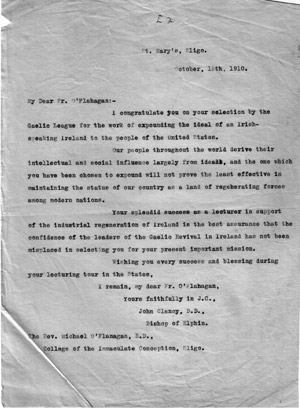
Mayor Buckingham after alluding to tune fact tn at tune day was Lincoln's birthday went on to speak of the part the Irish had borne in the memorable struggle of which Lincoln was the chief feature and also how they had fought valiantly in the Revolution and had been foremost in every fight for liberty, said he cordially approved of the Gaelic league movement at the conclusion of his remarks he introduced Rev. Father O'Flanagan.
The salutation of the reverend gentleman was given in Gaelic after which he dropped back into English which he handled with great ease and fluency.
He said that liberty was the greatest gift of God to man and was not given to any one nation but all, although some had to struggle longer and harder for it. Liberty was in the hearts of all. The Gaelic text book and the spear and lance are weapons for securing Irish liberty, and to let her live her own life, in her own way. The Irish people were a normal people and this movement was a normal one. Ireland had given this country over 5,000,000 of her best and average citizens and he thought they would compare as favorably as the people coming here from any other country. There was no place too big for an Irishman to aspire to and fill. There was nothing especially different from the other European races to the Irish people.
Danger to Civilization
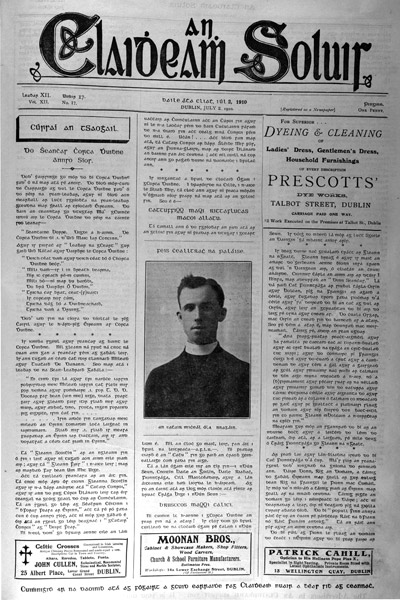
The speaker went on to speak of the crime of attempting to change a nation so as to make it resemble another and lose all of its own characteristics. He called this a great danger to the civilized world as well. The schools of America, which make this the most foremost country of the world, teach that all children should not be brought up alike but any particular bent or inclination of each should be fostered and encouraged. It was the same with the nations as with children, but in spite of alt this England had been laboring for centuries to make Ireland a second England, forgetful of the fact the people were radically different. This has resulted In losing to the world a distinctive nation and giving a second-rate England. The system of education pursued in Ireland is calculated to bring about this very result but the finished products of that system were very few and far between. He cited how the reading books used permitted but only a scanty reference to Ireland with laudatory ones of England and Englishmen. The sons of Irish landlords were educated in England and thus soon despised their native land where as if they were educated in Ireland it might be different and they might possibly be willing to do something for it.
Has Glorious Past
It has been decided that the remedy to counteract all this English system is to educate the Irish people in the Gaelic language so that they might become interested in Irish literature and history thus learning that Ireland has a glorious past. This remedy offered by the Gaelic league has been accepted by the people and after years of agitation the new Irish national university has decreed that beginning with 1918 all students must pass an examination in this language for admission. Now 3,066 primary schools In Ireland out of 8,000 teach this language, while in high schools and colleges still greater progress has been made. The idea is to nationalize the entire educational system in Ireland and through it to re-nationalize the entire country. This work cannot be done in a day or a year.
To supplement the work of the schools, 150 traveling teachers are employed. On Saturdays and Sundays, they teach the parents so that the language is now used ordinarily by about 750,000 people. It is thus giving new life and vigor to the Irish people. Under the auspices of these traveling teachers about 60 celebrations are held annually in Ireland at which prizes are given for the best song, speech, story and useful articles made in Gaelic. The pride of the country is being aroused to purchase articles 'Made in Ireland' in preference to those of English manufacture, in decided contrast, to what was done a few years ago. On St. 'Patrick's day collections for the league are taken up all over Ireland, that country contributing nearly $75,000 to its support, while about $225,000 comes from this country.
Movement Spreading
From then on the speaker eulogized the Gaelic language telling what it had been used for, how St. Patrick prayed it, how King. Brian Boru used it, and the like. Still it was allowed to fall into such a state that many of the Irish people were getting ashamed of it and had not the league taken it up it would soon have vanished from Ireland. This movement to restore this language to use has now extended to every part of Ireland, while the language had been if allowed to languish for one or two generations more would have died out entirely. No real Irishman can stand by and see this tragedy enacted. The speaker said he had strong hopes of the language and the Irish people. He looked forward to the day when the Gaelic language would roll back the flood of Anglicism which had so long threatened the nation Finnan McColum, the second speaker made hike remarks entirely in Gaelic, he speaking about 13 minutes and holding the close interest of his hearers. Chairman McCarthy closed the meeting, by stating to whom contributions might be made and extending to all an invitation to attend the meetings of the Irish Language society.
Bridgeport Evening Farmer, February 13, 1911.
ALL IRISH PARTIES UNITED IN MOVEMENT TO REVIVE GAELIC TONGUE AND ANCIENT ARTS
The Evening Times, Grand Forks, North Dakota. May 10, 1911.
By GEORGE WAUGH ARNOLD.
THAT it is possible to get Irish men together on one object and keep them enthusiastic workers at it for seventeen years, though they differ widely in religious and political views, is proved by the remarkable history of the Gaelic league.
Its messengers now in America from the parent body on the 'old sod' are the Rev. Father Michael O'Flanagan and Mr. Fionan MacColum, and to look after the art industry side of the campaign are the Misses Marian O'Shea, Brigit O'Quinn, Eileen Noone and Brlgit MacLaughlln. A mass meeting will be held in Chicago on May 11 to celebrate the success of their winter's propaganda, and they, hope to take back to the educational fund of the league an even greater fund than the $55,000 subscribed by American sympathizers five years ago.
League Has Dual Purpose
The league has two purposes. One is the restoration of Gaelic as a spoken tongue and the other the revival of Irish arts and Industries.
The headquarters are in Dublin, in charge of President Douglas Hyde, and there are branches in each of the thirty-two counties in Ireland, with a total membership of 50,000. When the league was organized there was scarcely a school in which Gaelic was taught. Now there are 181 schools in which the whole course of study is bilingual English and Gaelic - and in 3066 out of the 8,538 Irish primary schools the ancient language is taught either as an ordinary or as an added subject. Then the league has established six summer and four winter colleges in which Gaelic is the only language used. And the crowning victory is the determination of the senate of the National university to make Irish a necessary subject for entrance beginning with the year 1913.
The league's success in the revival of
arts and industries has been quite as
great. Thousands of young folks have
been made self supporting, and thousands more are making bigger salaries
than they ever dreamed of making except they emigrated.
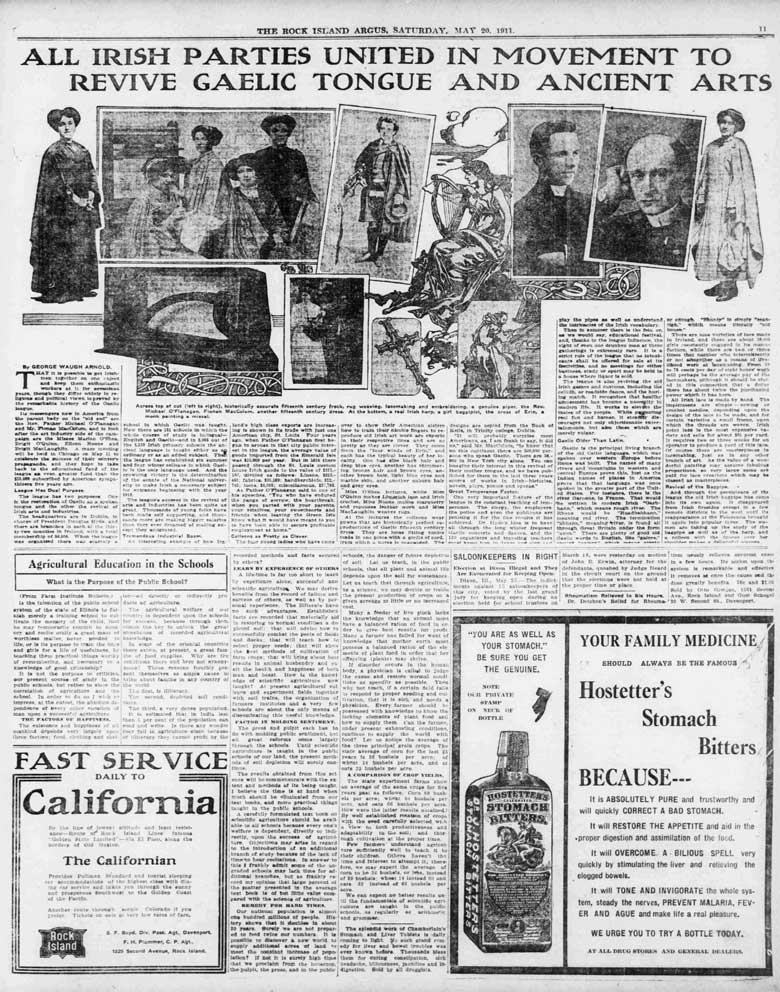
Across top of cut left to right: historically accurate fifteenth century frock, rug weaving, lace making and embroidering, a genuine piper, the Rev. Michael O'Fianagan, Fionan MacColum, another fifteenth century dress. At the bottom, a real Irish harp, a girl bagpipist, the cross of Erin, a monk painting a missal.
Tremendous Industrial Boom
An interesting example of how Ireland's high class exports are increasing is shown in its trade with just one American city, St. Louis. Four years ago, when Father O'Flanagan first began to arouse in that city public interest in the league, the average value of goods imported from the Emerald Isle was $20,000 per year. But In 1910 there passed through the St. Louis, custom house Irish goods to the value of $315,187, divided as follows: Linens, $233,488; fabrics, $25,189; handkerchiefs, $12,742 laces, $6,062; Miscellaneous, $87,766.
As Father O'Flanagan said in one of his speeches 'You who have endured the pangs of sorrow, the heartbreak, when you parted with your parents, your relatives, your sweethearts and friends when leaving the Green Isle know what it would have meant to you to have been able to secure profitable employment at home.'
Colleens as Pretty as Clever
The four young ladies who have come over to show their American sisters how to train their nimble fingers to reproduce old Irish art work are experts in their respective lines and are as pretty as they an clever. They come from the 'four winds of Erin,' and each has the typical beauty of her locality. One has sloe black hair and deep blue eyes, another has shimmering bronze hair and brown eyes, an other brown has light blue eyes and marble skin, and another auburn hair and gray eyes.
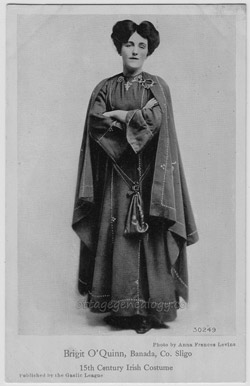
Miss O'Shea lectures, while Miss O'Quinn makes Limerick lace and Irish crochet. Miss Noone makes marquetry and repousse leather work and Miss MacLaughlln weaves rugs.
At the lectures the colleens wear gowns that are historically perfect reproductions of Gaelic fifteenth century dress. They are loose fitting tunics made in one piece with a girdle of cord, from which a purse is suspended. The designs are copied from the Book of Kells, in Trinity college, Dublin.
'It will probably surprise most Americans, as, I am frank to say, it did us,' said Mr. MacColum, 'to know that on this continent there are 500,000 per sons who speak Gaelic. There are 50,000 in New York city alone. You can imagine their interest in this revival of their mother tongue, and we have published for them in the last three years scores of works in Irish - histories, novels, plays, poems and operas.'
Great Temperance Factor
One very important feature of the league is its constant teaching of temperance. The clergy, the employers, the police and even the publicans are praising it for the fine results it has achieved. Dr. Hyde's idea is to have all through the long winter frequent Gaelic concerts and dances, and the 130 organizers and traveling teachers must know how to dance and sing and play the pipes as well as understand the intricacies of the Irish vocabulary.
Then in summer there is the fels, or, as we would say, educational festival, and, thanks to the league influence, the sight of even one drunken man at these gatherings is extremely rare. It is a strict rule of the league that no intoxicants shall be offered for sale at its festivities, and no meetings for either business, study or sport may be held in a house where liquor is sold.
The league is also reviving the old Irish games and customs, including the ceilidh, or roadside dance, and the hurling match. It recognizes that healthy amusement has become a necessity in modern life. It works to elevate the tastes of the people. While promoting real fun and humor, It steadily discourages not only objectionable entertainments, but also those which are merely vulgar.
Gaelic Older Than Latin
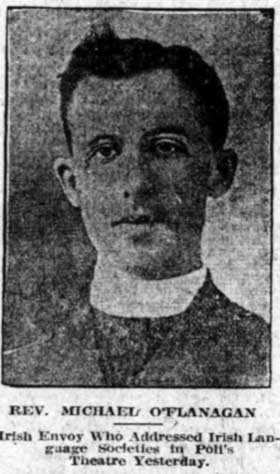
Gaelic is the principal living branch of the old Celtic language, which was spoken over western Europe before Rome was built. The names of many rivers and mountains in western and central Europe prove this, just as the Indian names of places in America prove that that language was once spoken In the greater part of the United States. For instance, there is the river Garonne in France. That would be written in Irish 'Garbhann,' which means rough river. The Rhone would be 'Ruadhabhann,' meaning red river. The termination 'abhann,' meaning 'river, is found all through Great Britain under the form 'avon.' There are plenty of good old Gaelic words in English, like 'galore,' spelled 'goleor,' which means plenty or enough. 'Shanty' is simply 'Sean tigh' which means 'Old House'.
There are nine varieties of lace made in Ireland, and there are about 10,000 girls constantly engaged in its manufacture, while there are two or three times that number who intermittently or not altogether as a means of livelihood work at lace making. From 50 to 75 cents per day of right hours work will perhaps be the average pay of the lace makers, although it should be stated in this connection that a dollar there has about twice the purchasing power which it has here.
All Irish lace is made by hand. The implements are simple sewing or crochet needles, depending upon the design of the lace to be made, and for certain varieties a small frame, upon which the threads are woven. Irish point lace is the most expensive variety and sells for about $35 per yard. It requires two or three weeks for an operator to produce a yard of this lace. Of course there are masterpieces in lace making, just as in any other branch of art. As the value of a wonderful painting may assume fabulous proportions, so very large sums are paid for lace creations which may be classed as masterpieces.
Revival of the Bagpipe
And through the persistence of the league the bagpipe has come into its own again. It disappeared from Irish firesides except a few remote districts in the west until its reappearance at the Feiseanna brought it again into popular favor. The women are taking up the study of the bagpipe well as of the harp, and a colleen with the drones over her shoulder makes a delightful picture.
UNDER the auspices of the O'Growney branch of the Gaelic league a public welcome will be given to Father O'Flanagan, who is is San Francisco in the Interest of the lace making Industry, of Ireland. The reception will be free to all, and men and women of Irish birth and descent are expected to attend in large numbers to hear Father O'Fianagan's address on the 'Irish Industrial movement.' Father O'Flanagan is a fluent, eloquent and interesting talker and his message from the old land will be well worth hearing.
The reception will be held at St. Peter's hall, Alabama and Twenty-fourth streets, next Tuesday evening, June 2 - A brief but select program of vocal and instrument selections will precede Father O'Flanagan's remarks as follows:
Michael O'Mahoney, principal of the O'Growney school, will introduce the chairman of the evening, who will be a man with rare knowledge of the Irish revival movement; chairman's address; Irish airs; the O'Growney musical society; Gaelic songs, children of St. Peter's school; selection of Irish airs on the violln by Professor Batt Scanlan; Gaelic song, Miss Loretto A. Barr; lecture on the national revival movement In Ireland, Rev. Father O'Flanagan; 'Slainte n-Gaedheal, Miss Loretto A. Barr, assisted by the members of the O'Growney school.
The committee in charge of the reception consists of Joseph Kelly, Conor Murphy, James J. Caniffe, Frank S. Drady, Michael O'Mahoney, Thomas O'Connor, Daniel O'Connell, Daniel Harnedy and Miss Frances X Barr. The doors will open promptly at 7 o'clock. The program will begin at 8 o'clock.

